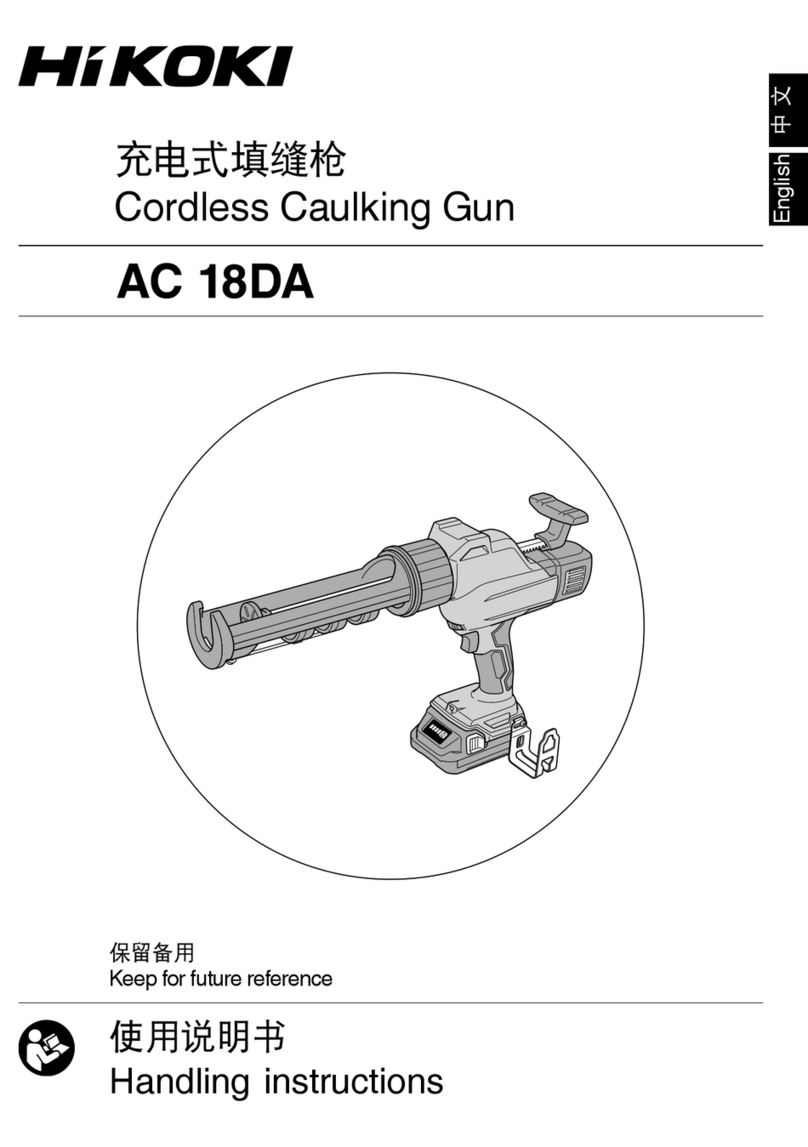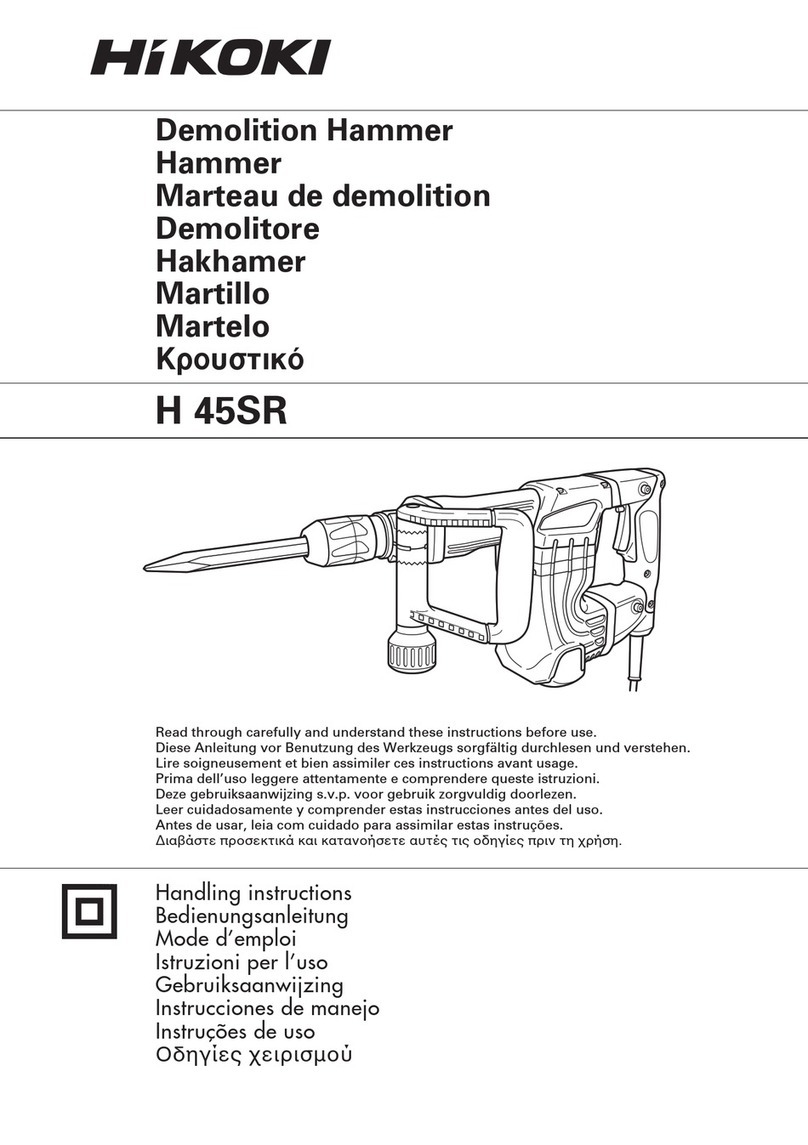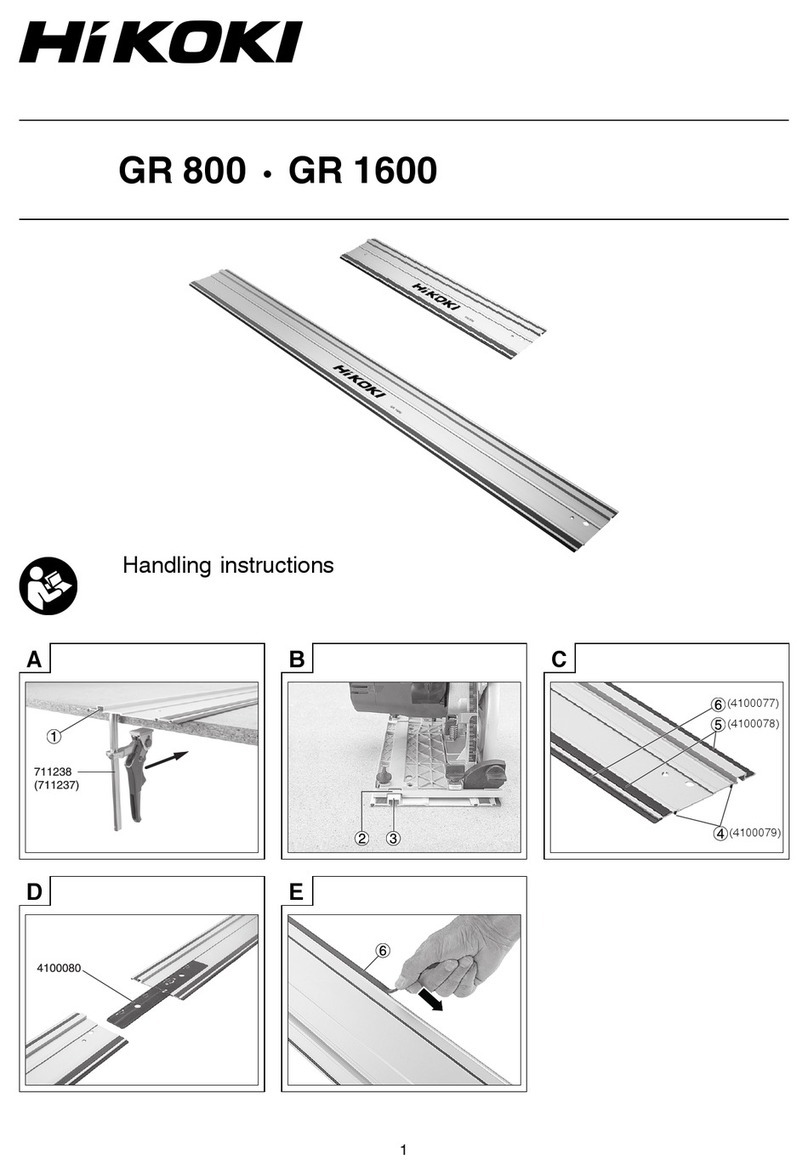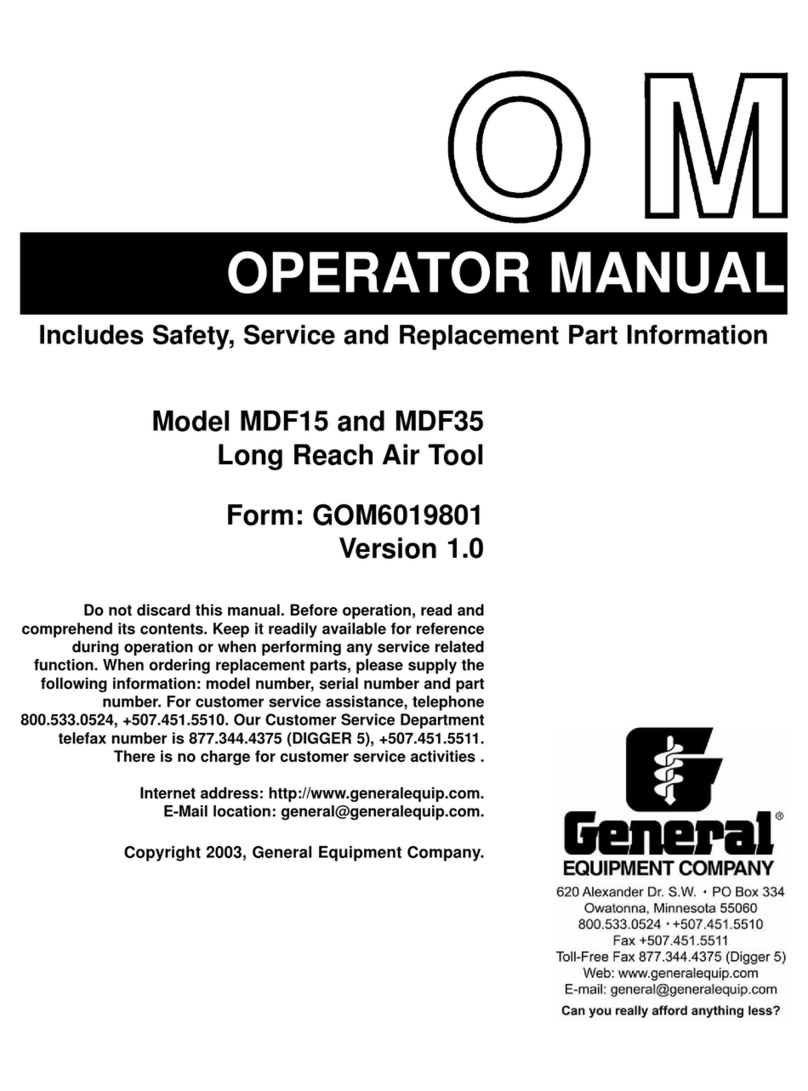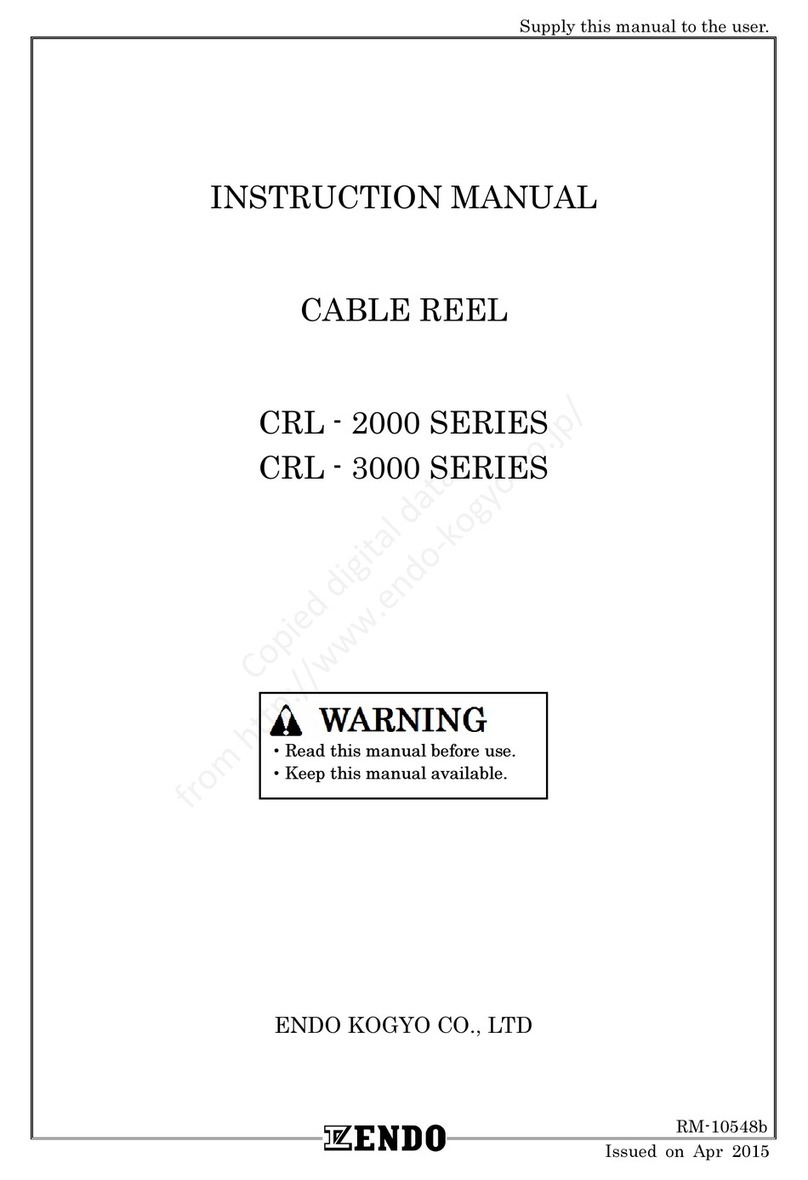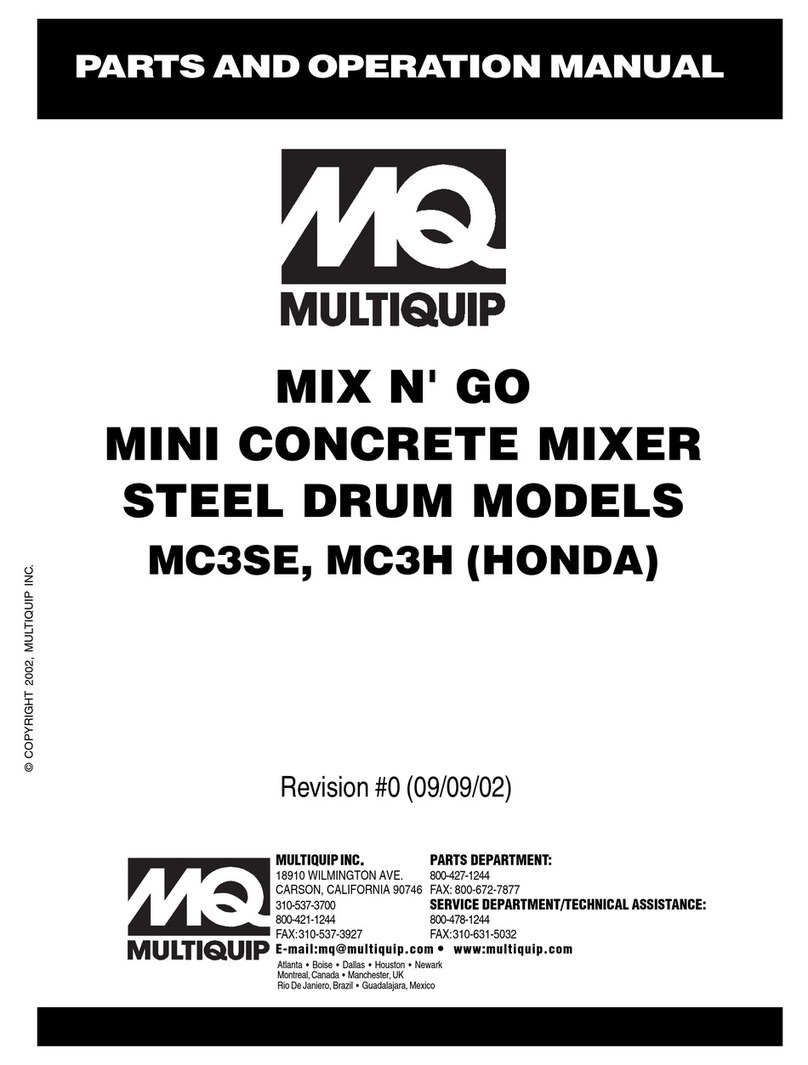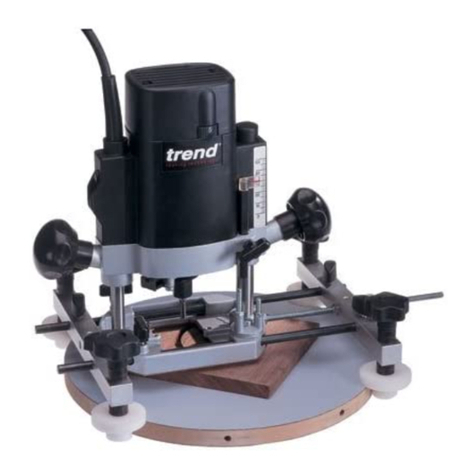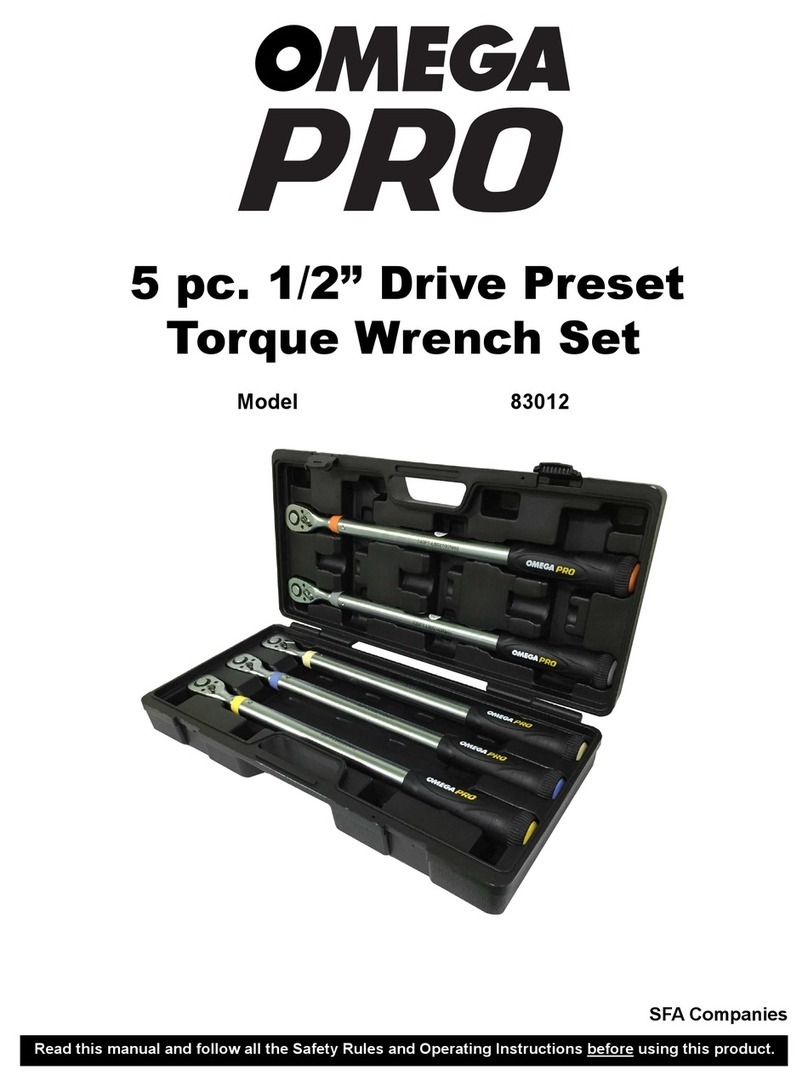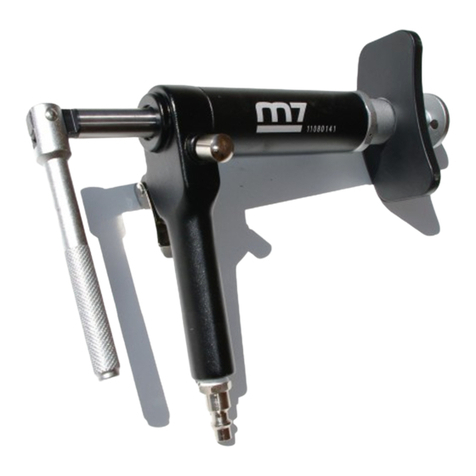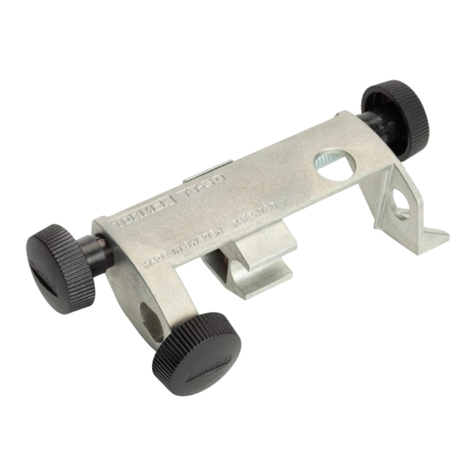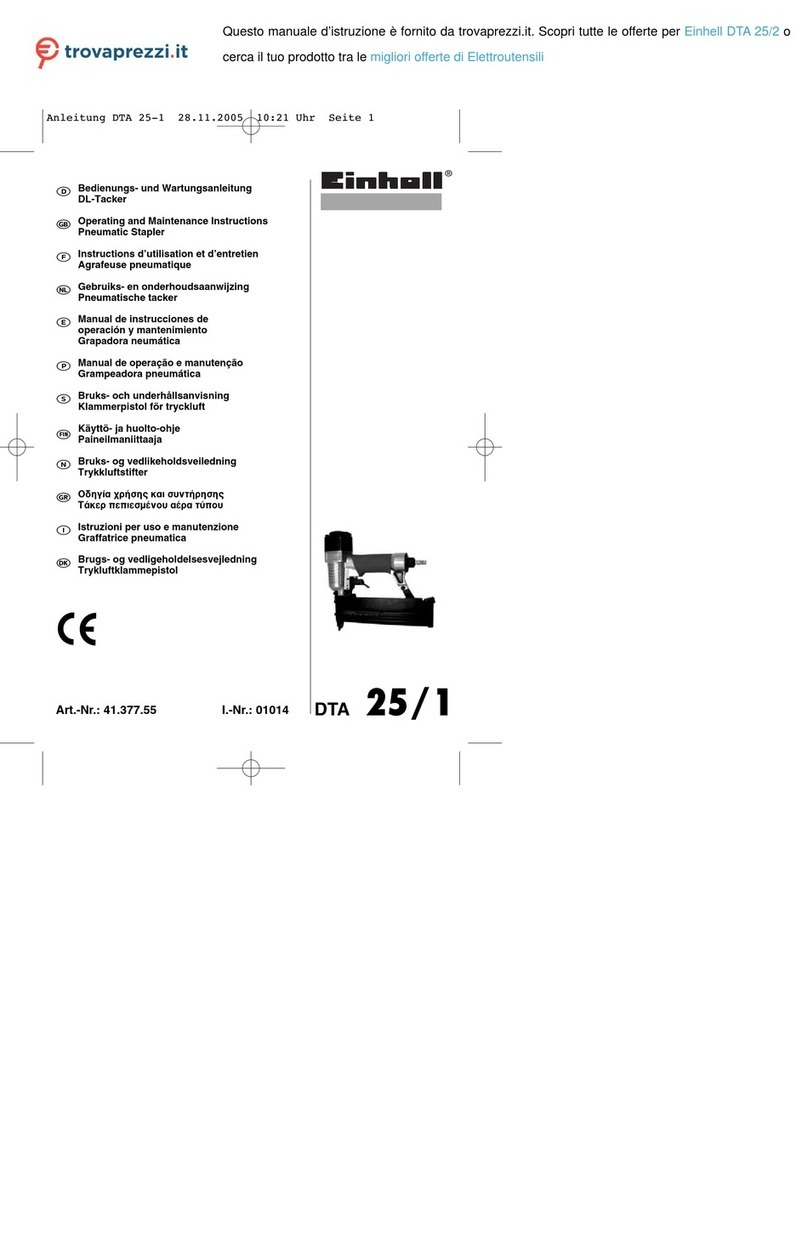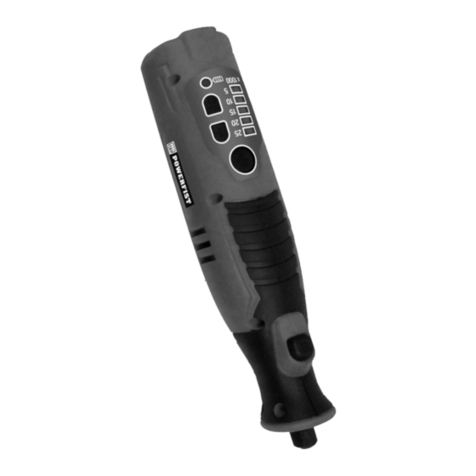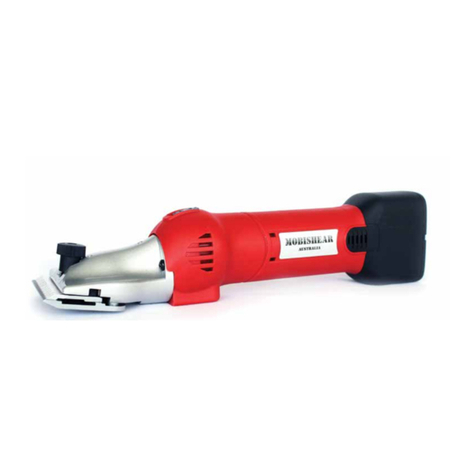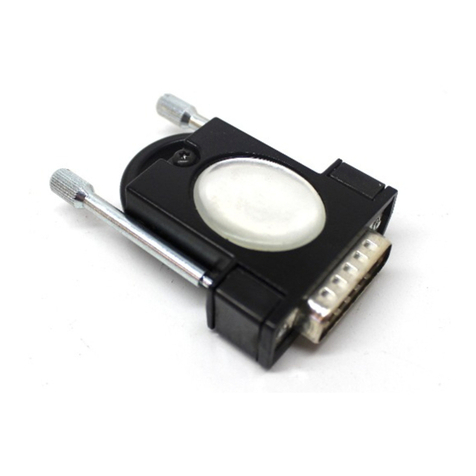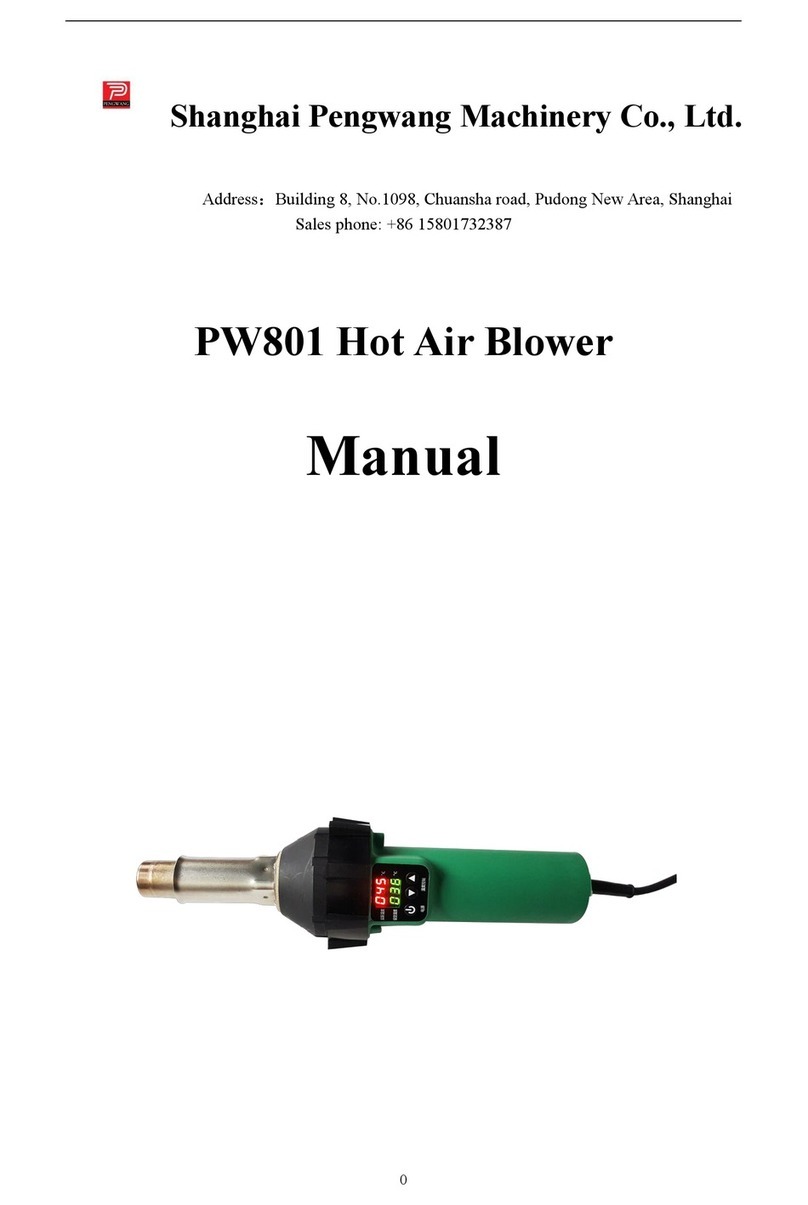HIKOKI SB3608DA User manual

Handling instructions
使用說明書
취급 설명서
Hướng dẫn sửdụng
คูมือการใชงาน
Petunjuk pemakaian
SB3608DA
en
zh
ko
vi
th
id
ar
en
zh
ko
vi
th
id
ar
00BookSB3608DAAsia.indb100BookSB3608DAAsia.indb1 2022/08/0514:38:552022/08/0514:38:55

2
1
23
00BookSB3608DAAsia.indb200BookSB3608DAAsia.indb2 2022/08/0514:39:212022/08/0514:39:21

3
4
5
6
00BookSB3608DAAsia.indb300BookSB3608DAAsia.indb3 2022/08/0514:39:222022/08/0514:39:22

4
78
1.6–3.0 mm
a
b
910
11
00BookSB3608DAAsia.indb400BookSB3608DAAsia.indb4 2022/08/0514:39:232022/08/0514:39:23

5
12
13 14
ab
15 16
00BookSB3608DAAsia.indb500BookSB3608DAAsia.indb5 2022/08/0514:39:242022/08/0514:39:24

6
English
c) Prevent unintentional starting. Ensure the
switch is in the off-position before connecting
to power source and/or battery pack, picking up
or carrying the tool.
Carrying power tools with your finger on the switch
or energising power tools that have the switch on
invites accidents.
d) Remove any adjusting key or wrench before
turning the power tool on.
A wrench or a key left attached to a rotating part of
the power tool may result in personal injury.
e) Do not overreach. Keep proper footing and
balance at all times.
This enables better control of the power tool in
unexpected situations.
f) Dress properly. Do not wear loose clothing or
jewellery. Keep your hair and clothing away
from moving parts.
Loose clothes, jewellery or long hair can be caught in
moving parts.
g) If devices are provided for the connection of
dust extraction and collection facilities, ensure
these are connected and properly used.
Use of dust collection can reduce dust-related
hazards.
h) Do not let familiarity gained from frequent use
of tools allow you to become complacent and
ignore tool safety principles.
A careless action can cause severe injury within a
fraction of a second.
4) Power tool use and care
a) Do not force the power tool. Use the correct
power tool for your application.
The correct power tool will do the job better and safer
at the rate for which it was designed.
b) Do not use the power tool if the switch does not
turn it on and off.
Any power tool that cannot be controlled with the
switch is dangerous and must be repaired.
c) Disconnect the plug from the power source and/
or remove the battery pack, if detachable, from
the power tool before making any adjustments,
changing accessories, or storing power tools.
Such preventive safety measures reduce the risk of
starting the power tool accidentally.
d) Store idle power tools out of the reach of
children and do not allow persons unfamiliar
with the power tool or these instructions to
operate the power tool.
Power tools are dangerous in the hands of untrained
users.
e) Maintain power tools and accessories. Check
for misalignment or binding of moving parts,
breakage of parts and any other condition
that may affect the power toolʼs operation. If
damaged, have the power tool repaired before
use.
Many accidents are caused by poorly maintained
power tools.
f) Keep cutting tools sharp and clean.
Properly maintained cutting tools with sharp cutting
edges are less likely to bind and are easier to control.
g) Use the power tool, accessories and tool bits
etc. in accordance with these instructions,
taking into account the working conditions and
the work to be performed.
Use of the power tool for operations different from
those intended could result in a hazardous situation.
GENERAL POWER TOOL SAFETY
WARNINGS
WARNING
Read all safety warnings, instructions, illustrations and
specifications provided with this power tool.
Failure to follow all instructions listed below may result in
electric shock, fire and/or serious injury.
Save all warnings and instructions for future reference.
The term “power tool” in the warnings refers to your mains-
operated (corded) power tool or battery-operated (cordless)
power tool.
1) Work area safety
a) Keep work area clean and well lit.
Cluttered or dark areas invite accidents.
b) Do not operate power tools in explosive
atmospheres, such as in the presence of
flammable liquids, gases or dust.
Power tools create sparks which may ignite the dust
or fumes.
c) Keep children and bystanders away while
operating a power tool.
Distractions can cause you to lose control.
2) Electrical safety
a) Power tool plugs must match the outlet. Never
modify the plug in any way. Do not use any
adapter plugs with earthed (grounded) power
tools.
Unmodified plugs and matching outlets will reduce
risk of electric shock.
b) Avoid body contact with earthed or grounded
surfaces, such as pipes, radiators, ranges and
refrigerators.
There is an increased risk of electric shock if your
body is earthed or grounded.
c) Do not expose power tools to rain or wet
conditions.
Water entering a power tool will increase the risk of
electric shock.
d) Do not abuse the cord. Never use the cord for
carrying, pulling or unplugging the power tool.
Keep cord away from heat, oil, sharp edges or
moving parts.
Damaged or entangled cords increase the risk of
electric shock.
e) When operating a power tool outdoors, use an
extension cord suitable for outdoor use.
Use of a cord suitable for outdoor use reduces the
risk of electric shock.
f) If operating a power tool in a damp location
is unavoidable, use a residual current device
(RCD) protected supply.
Use of an RCD reduces the risk of electric shock.
3) Personal safety
a) Stay alert, watch what you are doing and use
common sense when operating a power tool.
Do not use a power tool while you are tired
or under the influence of drugs, alcohol or
medication.
A moment of inattention while operating power tools
may result in serious personal injury.
b) Use personal protective equipment. Always
wear eye protection.
Protective equipment such as a dust mask, non-skid
safety shoes, hard hat or hearing protection used for
appropriate conditions will reduce personal injuries.
00BookSB3608DAAsia.indb600BookSB3608DAAsia.indb6 2022/08/0514:39:252022/08/0514:39:25

7
English
h) Keep handles and grasping surfaces dry, clean
and free from oil and grease.
Slippery handles and grasping surfaces do not
allow for safe handling and control of the tool in
unexpected situations.
5) Battery tool use and care
a) Recharge only with the charger specified by the
manufacturer.
A charger that is suitable for one type of battery pack
may create a risk of fire when used with another
battery pack.
b) Use power tools only with specifically
designated battery packs.
Use of any other battery packs may create a risk of
injury and fire.
c) When battery pack is not in use, keep it away
from other metal objects, like paper clips, coins,
keys, nails, screws or other small metal objects,
that can make a connection from one terminal to
another.
Shorting the battery terminals together may cause
burns or a fire.
d) Under abusive conditions, liquid may be ejected
from the battery; avoid contact. If contact
accidentally occurs, flush with water. If liquid
contacts eyes, additionally seek medical help.
Liquid ejected from the battery may cause irritation or
burns.
e) Do not use a battery pack or tool that is damaged
or modified.
Damaged or modified batteries may exhibit
unpredictable behaviour resulting in fire, explosion
or risk of injury.
f) Do not expose a battery pack or tool to fire or
excessive temperature.
Exposure to fire or temperature above 130°C may
cause explosion.
g) Follow all charging instructions and do not
charge the battery pack or tool outside the
temperature range specified in the instructions.
Charging improperly or at temperatures outside
the specified range may damage the battery and
increase the risk of fire.
6) Service
a) Have your power tool serviced by a qualified
repair person using only identical replacement
parts.
This will ensure that the safety of the power tool is
maintained.
b) Never service damaged battery packs.
Service of battery packs should only be performed
by the manufacturer or authorized service providers.
PRECAUTION
Keep children and infirm persons away.
When not in use, tools should be stored out of reach of
children and infirm persons.
CORDLESS BELT SANDER SAFETY
WARNINGS
Hold the power tool by insulated gripping surfaces,
because the sanding surface may contact hidden
wiring. Cutting a “live” wire may make exposed metal
parts of the power tool “live” and could give the operator an
electric shock.
ADDITIONAL SAFETY WARNINGS
1. Use clamps or another practical way to secure and
support the workpiece to a stable platform.
Holding the workpiece by hand or against your body
leaves it unstable and may lead to loss of control.
2. Attaching and removing the dust bag
Prior to the sanding operation, make sure the material of
surface you are going to sand.
If the surface under sanding operation is expected to
generate harmful / toxic dusts such as lead painted
surface, make sure the dust bag or appropriate dust
extraction system is connected with dust outlet tightly.
Wear the dust mask additionally, if available.
Do not inhale or touch the harmful / toxic dusts generated
in sanding operation, the dust can endanger the health
of yourself and bystanders.
3. Never apply water or grinding fluid when sanding. This
could result in electrical shock.
4. Never turn the power switch ON when the sander is
contacting the surface to be sanded. This is necessary
to preclude damage to the material. The same applies
when switching the power OFF.
5. DO NOT apply excessive pressure to the sander while
sanding. Excessive-pressure may cause overload of
the motor, reduced service life of the sanding belt, and
lowered sanding or polishing efficiency.
6. Never touch moving parts.
Never place your hands, fingers or other body parts near
the tool’s moving parts.
7. NEVER leave tool running unattended. Turn power off.
Don’t leave tool until it comes to a complete stop.
8. When operating the tool, do not wear work gloves as
such cloth wear can get caught in the tool.
9. Do not leave the tool running. Operate the tool only when
hand-held.
10. Make sure that there are no cracks, scratches, or other
abnormalities on the sanding belt before use.
11. Accessories must be securely mounted to the tool.
Prevent potential injuries to yourself or others.
Accessories which have been mounted to the tool
should be secure and tight.
12. Use the sanding belt and accessories specified by
HiKOKI.
13. When sanding metal, sparks are generated. Keep other
persons and flammable substances away from the work
area.
14. Sanding belt installed in the wrong direction will lower
work efficiency and shorten life of sanding belt.
15. If sanding belt moves during operation, adjustment can
be made while in operation.
16. Sanding by applying impact and cutting by sideof-belt
contact should be avoided.
17. Be careful of sanding sparks.
18. As certain that the sanding workpiece contains neither
nails nor other harmful foreign matter.
19. Sanding glass fiber not recommended.
20. After operation, blow away the dust on the belt and the
pulleys.
21. Place the workpiece on a stable surface when sanding.
22. Do not sand a steel plate for extended periods while
applying excessive pressure.
There is a risk that hot sanding particles could damage
the dust bag.
23. If you notice that the unit is generating unusually high
temperatures, operating poorly, or making abnormal
noises, immediately stop using and shut offthe power
switch. Request an inspection and repair from the dealer
where you purchased the unit or a HiKOKI Authorized
Service Center.
Continuing to use while operating abnormally might
cause injuries.
00BookSB3608DAAsia.indb700BookSB3608DAAsia.indb7 2022/08/0514:39:252022/08/0514:39:25

8
English
24. If the unit is mistakenly dropped or strikes another object,
make a thorough check of the unit for cracks, breakage
or deformation, etc.
Injuries might occur if the unit has cracks, breakage or
deformation.
25. When working at elevated locations, clear the area of
other people and aware of conditions below you.
26. Always charge the battery at a temperature of 0°C–40°C.
A temperature of less than 0°C will result in over charging
which is dangerous. The battery cannot be charged at a
temperature higher than 40°C.
The most suitable temperature for charging is that of
20°C–25°C.
27. Do not use the charger continuously.
When one charging is completed, leave the charger for
about 15 minutes before the next charging of battery.
28. Do not allow foreign matter to enter the hole for
connecting the rechargeable battery.
29. Never disassemble the rechargeable battery and
charger.
30. Never short-circuit the rechargeable battery.
Shortcircuiting the battery will cause a great electric
current and overheat. It results in burn or damage to the
battery.
31. Do not dispose of the battery in fire. If the battery is burnt,
it may explode.
32. Bring the battery to the shop from which it was purchased
as soon as the post-charging battery life becomes too
short for practical use. Do not dispose of the exhausted
battery.
33. Do not insert object into the air ventilation slots of the
charger. Inserting metal objects or inflammables into the
charger air ventilation slots will result in electrical shock
hazard or damaged charger.
34. When using this unit continuously, the unit may overheat,
leading to damage in the motor and switch. Therefore,
whenever the housing becomes hot, give the tool a
break for a while.
35. Make sure that the battery is installed firmly. If it is at all
loose it could come offand cause an accident.
36. Do not use the product if the tool or the battery terminals
(battery mount) are deformed.
Installing the battery could cause a short circuit that
could result in smoke emission or ignition.
37. Keep the tool’s terminals (battery mount) free of swarf
and dust.
○Prior to use, make sure that swarf and dust have not
collected in the area of the terminals.
○During use, try to avoid swarf or dust on the tool from
falling on the battery.
○When suspending operation or after use, do not leave
the tool in an area where it may be exposed to falling
swarf or dust.
Doing so could cause a short circuit that could result in
smoke emission or ignition.
38. Always use the tool and battery at temperatures between
-5°C and 40°C.
CAUTION ON LITHIUM-ION BATTERY
To extend the lifetime, the lithium-ion battery equips with the
protection function to stop the output.
In the cases of 1 to 3 described below, when using this
product, even if you are pulling the switch, the motor may
stop. This is not the trouble but the result of protection
function.
1. When the battery power remaining runs out, the motor
stops.
In such a case, charge it up immediately.
2. If the tool is overloaded, the motor may stop. In this
case, release the switch of tool and eliminate causes of
overloading. After that, you can use it again.
3. If the battery is overheated under overload work, the
battery power may stop.
In this case, stop using the battery and let the battery
cool. After that, you can use it again.
Furthermore, please heed the following warning and caution.
WARNING
In order to prevent any battery leakage, heat generation,
smoke emission, explosion and ignition beforehand, please
be sure to heed the following precautions.
1. Make sure that swarf and dust do not collect on the
battery.
○During work make sure that swarf and dust do not fall on
the battery.
○Make sure that any swarf and dust falling on the power
tool during work do not collect on the battery.
○Do not store an unused battery in a location exposed to
swarf and dust.
○Before storing a battery, remove any swarf and dust that
may adhere to it and do not store it together with metal
parts (screws, nails, etc.).
2. Do not pierce battery with a sharp object such as a
nail, strike with a hammer, step on, throw or subject the
battery to severe physical shock.
3. Do not use an apparently damaged or deformed battery.
4. Do not use the battery for a purpose other than those
specified.
5. If the battery charging fails to complete even when a
specified recharging time has elapsed, immediately stop
further recharging.
6. Do not put or subject the battery to high temperatures or
high pressure such as into a microwave oven, dryer, or
high pressure container.
7. Keep away from fire immediately when leakage or foul
odor are detected.
8. Do not use in a location where strong static electricity
generates.
9. If there is battery leakage, foul odor, heat generated,
discolored or deformed, or in any way appears abnormal
during use, recharging or storage, immediately remove it
from the equipment or battery charger, and stop use.
10. Do not immerse the battery or allow any fluids to flow
inside. Conductive liquid ingress, such as water, can
cause damage resulting in fire or explosion. Store your
battery in a cool, dry place, away from combustible and
flammable items. Corrosive gas atmospheres must be
avoided.
CAUTION
1. If liquid leaking from the battery gets into your eyes,
do not rub your eyes and wash them well with fresh
clean water such as tap water and contact a doctor
immediately.
If left untreated, the liquid may cause eye-problems.
2. If liquid leaks onto your skin or clothes, wash well with
clean water such as tap water immediately.
There is a possibility that this can cause skin irritation.
3. If you find rust, foul odor, overheating, discolor,
deformation, and/or other irregularities when using the
battery for the first time, do not use and return it to your
supplier or vendor.
WARNING
If a conductive foreign matter enters in the terminal of lithium
ion battery, the battery may be shorted, causing fire. When
storing the lithium ion battery, obey surely the rules of
following contents.
○Do not place conductive debris, nail and wires such as
iron wire and copper wire in the storage case.
○To prevent shorting from occurring, load the battery in
the tool or insert securely the battery cover for storing
until the ventilator is not seen.
00BookSB3608DAAsia.indb800BookSB3608DAAsia.indb8 2022/08/0514:39:252022/08/0514:39:25

9
English
NAMES OF PARTS (Fig. 1–Fig. 16)
Handle knob
Drive pulley rotation
direction arrow
(marking)
Housing Lever
Sanding belt Idle pulley
Guard Ventilation holes
Adjust screw Motor
Belt cover Latch
Slide fastener Charge indicator lamp
Dust bag Arrows on the inside of
the belt
Duct Side of housing
Trigger switch Battery level indicator
switch
Lock on button Battery level indicator
lamp
Dial Air blow gun
Nameplate Terminal (Battery)
Handle Sliding grooves
Battery Terminal (Product)
Drive pulley Battery sliding grooves
SYMBOLS
WARNING
The following show symbols used for the machine.
Be sure that you understand their meaning before
use.
SB3608DA: Cordless Belt Sander
To reduce the risk of injury, user must read
instruction manual.
Direct current
V Rated voltage
n0No-load speed
/min Revolution or reciprocations per minute
Disconnect the battery
Switching ON
Switching OFF
Lock
Switch locks to the "ON" position
REGARDING LITHIUM-ION BATTERY
TRANSPORTATION
When transporting a lithium-ion battery, please observe the
following precautions.
WARNING
Notify the transporting company that a package contains a
lithium-ion battery, inform the company of its power output
and follow the instructions of the transportation company
when arranging transport.
○Lithium-ion batteries that exceed a power output of
100 Wh are considered to be in the freight classification
of Dangerous Goods and will require special application
procedures.
○For transportation abroad, you must comply with
international law and the rules and regulations of the
destination country.
Power Output
2 to 3 digit number
USB DEVICE CONNECTION
PRECAUTIONS
When an unexpected problem occurs, the data in a USB
device connected to this product may be corrupted or lost.
Always make sure to back up any data contained in the USB
device prior to use with this product.
Please be aware that our company accepts absolutely no
responsibility for any data stored in a USB device that is
corrupted or lost, nor for any damage that may occur to a
connected device.
WARNING
○Prior to use, check the connecting USB cable for any
defect or damage.
Using a defective or damaged USB cable can cause
smoke emission or ignition.
○When the product is not being used, cover the USB port
with the rubber cover.
Buildup of dust etc. in the USB port can cause smoke
emission or ignition.
NOTE
○There may be an occasional pause during USB
recharging.
○When a USB device is not being charged, remove the
USB device from the charger.
Failure to do so may not only reduce the battery life
of a USB device, but may also result in unexpected
accidents.
○It may not be possible to charge some USB devices,
depending on the type of device.
00BookSB3608DAAsia.indb900BookSB3608DAAsia.indb9 2022/08/0514:39:252022/08/0514:39:25

10
English
Lock
Unlock
Warning
Battery
Lights ;
The battery remaining power is over 75%
Lights ;
The battery remaining power is 50%–75%.
Lights ;
The battery remaining power is 25%–50%.
Lights ;
The battery remaining power is less than 25%
Blinks ;
The battery remaining power is nearly empty.
Recharge the battery soonest possible.
Blinks ;
Output suspended due to high temperature.
Remove the battery from the tool and allow it to
fully cool down.
Blinks ;
Output suspended due to failure or malfunction.
The problem may be the battery so please
contact your dealer.
STANDARD ACCESSORIES
In addition to the main unit (1 unit), the package contains the
accessories listed on page 66.
Standard accessories are subject to change without notice.
APPLICATIONS
○Finish sanding and finish flooring of woodwork products.
○Base polishing of wood-coated surfaces.
○Finish sanding of metal surfaces.
○Base polishing of metal-coated surfaces, rust removal,
or paint removal prior to refinishing.
○Surface finishing of slate, concrete, and similar materials.
SPECIFICATIONS
1. Power tool
Model SB3608DA
Voltage 36 V
No-load belt speed 122–450 m/min
Sanding belt size 76 × 533 mm
Battery available for this
tool* Multi volt battery
Weight 4.2 kg (BSL36A18)
4.5 kg (BSL36B18)
* Existing batteries (BSL3660/3620/3626, BSL18 series,
etc.) cannot be used with this tool.
NOTE
Due to HiKOKI’s continuing program of research and
development, the specifications herein are subject to
change without prior notice.
Electronic control
○Braking Function
Brake is activated when the switch is turned off, stopping
the motor’s rotation.
○Soft start
○Variable speed
○Constant speed
○Overload protection
This protection feature cuts offthe power to the motor
in the event of overloading of motor or a conspicuous
reduction in rotational speed during operation.
When the overload protection feature has been
activated, the motor may stop.
In this case, release the tool switch and eliminate causes
of overloading.
After that you can use it again.
○Overheat protection
This protection feature cuts offthe power to the motor
and stops the power tool in the event of overheating of
motor during operation.
When the overheat protection feature has been
activated, the motor may stop.
In this case, release the tool switch and cool it down in a
few minutes.
After that you can use it again.
○Restart prevention function
When the power is still switched on, the tool will not
restart when a battery is installed. This function can be
canceled once the tool is switched off.
2. Battery
Model BSL36A18
Voltage 36 V / 18 V
(Automatic Switching*)
Battery capacity 2.5 Ah / 5.0 Ah
(Automatic Switching*)
* The tool itself will automatically switch over.
CHARGING
Before using the power tool, charge the battery as follows.
1. Connect the charger’s power cord to the receptacle.
When connecting the plug of the charger to a receptacle,
the charge indicator lamp will blink in red (At 1- second
intervals).
2. Insert the battery into the charger.
Firmly insert the battery into the charger as shown in
Fig. 3.
3. Charging
When inserting a battery in the charger, the charge
indicator lamp will blink in blue.
When the battery becomes fully recharged, the charge
indicator lamp will light up in green. (See Table 1)
00BookSB3608DAAsia.indb1000BookSB3608DAAsia.indb10 2022/08/0514:39:272022/08/0514:39:27

11
English
(1) Charge indicator lamp indication
The indications of the charge indicator lamp will be as
shown in Table 1, according to the condition of the
charger or the rechargeable battery.
Table 1
Charger
status
Status of indicator
lamp Indication meaning
Before
charging
ON/OFF at 0.5 sec.
intervals (RED) Plugged into power
source *1
While
charging
Lights for 0.5 sec.
at intervals of 1 sec.
(BLUE)
Charged at less than
50%
Lights for 1 sec. at
intervals of 0.5 sec.
(BLUE)
Charged at less than
80%
Lights continuously
(BLUE) Charged at more
than 80%
Charging
complete
Lights continuously
(GREEN)
(Continuous buzzer
sound: about 6 sec.)
Overheat
standby
ON/OFF at 0.3 sec.
intervals (RED) Battery overheated.
Unable to charge. *2
Charging
impossible
ON/OFF at 0.1 sec.
intervals (PURPLE)
(Intermittent buzzer
sound; about 2 sec.)
Malfunction in
the battery or the
charger *3
*1 If the red lamp continues to blink even after the charger
has been attached, check to confirm that the battery has
been fully inserted.
*2 Although charging will start once the battery has cooled
down even when left in situ, the best practice is to
remove the battery and allow it to cool down in a shaded,
well-ventilated location before charging.
*3
○Fully insert the battery.
○Check to confirm that no foreign matter is stuck to the
battery mount or terminals.
<If charging takes a long time>
○Charging will take longer at extremely low ambient
temperatures. Charge the battery in a warm location
(such as indoors).
○Do not block the air vent. Otherwise the interior will
overheat, reducing the charger’s performance.
○If the cooling fan is not operating, contact a HiKOKI
Authorized Service Center for repairs.
(2) Regarding the temperatures and charging time of the
rechargeable battery
The temperatures and charging time will become as
shown in Table 2.
Table 2
Model UC18YSL3
Type of battery Li-ion
Charging voltage 14.4–18 V
Temperatures at which the battery
can be recharged 0°C–50°C
Charging time for
battery capacity,
approx.
(At 20°C)
1.5 Ah 15 min
2.0 Ah 20 min
2.5 Ah 25 min
3.0 Ah
20 min
(BSL1430C,
BSL1830C: 30 min)
4.0 Ah 26 min
(BSL1840M: 40 min)
5.0 Ah 32 min
6.0 Ah 38 min
8.0 Ah 52 min
Multi
volt
battery
1.5 Ah (× 2 unit)
20 min
2.5 Ah (× 2 unit)
32 min
4.0 Ah (× 2 unit)
52 min
Number of battery cells 4–10
Charging voltage for USB 5 V
Charging current for USB 2 A
Weight 0.6 kg
NOTE
The recharging time may vary according to the ambient
temperature and power source voltage.
CAUTION
When the battery charger has been continuously used,
the battery charger will be heated, thus constituting
the cause of the failures. Once the charging has been
completed, give 15 minutes rest until the next charging.
4. Disconnect the charger’s power cord from the
receptacle.
5. Hold the charger firmly and pull out the battery.
NOTE
Be sure to pull out the battery from the charger after use,
and then keep it.
Regarding electric discharge in case of new batteries,
etc.
As the internal chemical substance of new batteries and
batteries that have not been used for an extended period
is not activated, the electric discharge might be low when
using them the first and second time. This is a temporary
phenomenon, and normal time required for recharging
will be restored by recharging the batteries 2–3 times.
00BookSB3608DAAsia.indb1100BookSB3608DAAsia.indb11 2022/08/0514:39:272022/08/0514:39:27

12
English
How to make the batteries perform longer.
(1) Recharge the batteries before they become completely
exhausted.
When you feel that the power of the tool becomes
weaker, stop using the tool and recharge its battery. If
you continue to use the tool and exhaust the electric
current, the battery may be damaged and its life will
become shorter.
(2) Avoid recharging at high temperatures.
A rechargeable battery will be hot immediately after
use. If such a battery is recharged immediately after
use, its internal chemical substance will deteriorate, and
the battery life will be shortened. Leave the battery and
recharge it after it has cooled for a while.
CAUTION
○If the battery is charged while it is heated because
it has been left for a long time in a location subject to
direct sunlight or because the battery has just been
used, the charge indicator lamp of the charger lights
for 0.3 seconds, does not light for 0.3 seconds (offfor
0.3 seconds). In such a case, first let the battery cool,
then start charging.
○When the charge indicator lamp flickers (at 0.2-second
intervals), check for and take out any foreign objects in
the charger’s battery connector. If there are no foreign
objects, it is probable that the battery or charger is
malfunctioning. Take it to your authorized Service
Center.
MOUNTING AND OPERATION
Action Figure Page
Removing and inserting the battery*122
Charging 3 2
Installing the sanding belt*243
How to use the dust bag*353
Switch operation 6 3
About the mode change function*474
How to adjust sanding belt position*584
How to hold and move the belt sander*694
How to work on corner 10 4
Remaining battery indicator 11 4
Charging a USB device from an
electrical outlet 14-a 5
Charging a USB device and battery
from an electrical outlet 14-b 5
How to recharge USB device 15 5
When charging of USB device is
completed 16 5
Selecting accessories ―67
*1 Removing and inserting the battery
CAUTION
Before installing or removing the battery, turn the switch
to the OFF position.
If the battery is inserted with the switch in the ON
position, the motor will operate unexpectedly.
*2 Installing the sanding belt
Align the arrow on the inside of the sanding belt with the
direction of the mark on the tool and install it.
CAUTION
○Use only sanding belt size specified on the product
nameplate.
○Sanding belt installed in the wrong direction will lower
work efficiency and shorten life of sanding belt.
○Avoid pinching your fingers when opening and closing
the lever.
NOTE
○The drive pulley and idle pulley will be hot after use.
○Use an air blow gun or similar device to remove any
debris from around the pulleys with the sanding belt
removed.
*3 How to use the dust bag
WARNING
Clean the dust bag before and after sanding metal, and
remove any sanding dust from inside. Metal sanding
dust can cause fires.
*4 About the mode change function
The unit has “Transmission mode” and “Auto mode”.
○With Transmission mode, the belt sander's number of
revolutions can be set at one of five stages.
When operating in Transmission mode, the set number
of revolutions will be maintained regardless of changes
in load.
○With Auto mode, you can lower noise and vibration by
lowering the maximum number of revolutions while in a
no-load state.
While in Auto mode, the number of revolutions will be
raised if the load becomes greater during operation.
On the other hand, the number of revolutions will be
lowered if the load decreases during operation. (Table 3)
○Set the mode and dial according to work application.
Table 3
Dial setting Belt speed
1 122 m/min
2 220 m/min
3 310 m/min
44
0
0 m/min
5 450 m/min
A122 m/min (No load)
45
0
m/min (With load)
*5 How to adjust sanding belt position
WARNING
○If the sanding belt is positioned too close to the inside, it
may come into contact with the guard, producing sparks.
○Do not peer inside between the sanding belt and
housing. Doing so risks dust or other debris entering
your eyes.
NOTE
○If sanding belt moves during operation, adjustment can
be made while in operation.
○Setting the dial to low speed (e.g., mode 1) makes it
easier to adjust.
○If the sanding belt is positioned too close to the inside, it
may come into contact with the guard, causing the belt to
tear.
00BookSB3608DAAsia.indb1200BookSB3608DAAsia.indb12 2022/08/0514:39:272022/08/0514:39:27

13
English
*6 How to hold and move the belt sander
○Remove the tool from the workpiece and turn on the
trigger switch. When finishing, turn offthe trigger switch
after the tool is removed from the workpiece, and set the
tool down after the rotation has stopped.
○Grasp handle and handle knob and hold machine
against surface to be worked on so that it contacts
surface lightly.
○Hold both handles firmly, and take great care to keep
your fingers away from the pulleys and sanding belt
while working.
○Weight of machine itself is sufficient for sanding and
polishing at highest efficiency.
○Do not apply any additional pressure, for this would
place unnecessary load on motor, shorten life of sanding
belt and lower work efficiency.
○Choose sanding belt of proper grain size and grain type
for your specific purpose, by referring to Table 4 and 5
below.
Table 4
Derived finish Proper grain size
Coarse finish 30–40
Medium finish 40–100
Semi fine finish 80–240
Fine finish 180–400
Table 5
Grain type Surface to be worked on
AA Steel, Wood
WA Wood, Bamboo
MAINTENANCE AND INSPECTION
WARNING
Be sure to turned offthe switch and remove the battery
before maintenance and inspection.
1. Empting and cleaning the Dust Bag
Clean the dust bag after working to remove any sanding
dust. (Fig. 5)
NOTE
If too much dust accumulates in the dust bag, the dust
collection power will be reduced.
Dispose of dust as soon as possible.
2. Inspecting the sanding beIt
The abrasive performance of the sanding belt will
decrease if its abrasive particles become worn away or
clogged, greatly reducing the efficiency of the tool. If this
occurs, replace with a new sanding belt.
3. Cleaning on the outside
When the power tool is stained, wipe with a soft dry cloth
or a cloth moistened with soapy water. Do not use chloric
solvents, gasoline or paint thinner, for they melt plastics.
4. Cleaning the battery installation compartment and
the battery
WARNING
Wear protective glasses and a dust mask when cleaning
with an air blow gun.
Failure to do so may result in inhalation or exposure of
the eyes to debris or dust.
After working, if sanding dust has accumulated on the
battery installation compartment and the battery, clean
offthe accumulated sanding dust with an air blow gun or
a dry cloth before using the tool. (Fig. 12)
NOTE
○After cleaning, ensure that the battery can be installed
and removed smoothly from the tool.
○Using the tool when the battery is covered with sanding
dust may lead to accidents such as the battery falling
during use.
Furthermore, such use may cause a malfunction or
contact failure between the battery and terminals.
5. Maintenance of the motor
The motor unit winding is the very “heart” of the power
tool. Exercise due care to ensure the winding does not
become damaged and/or wet with oil or water.
6. Storage
Store the power tool and battery in a place in which
the temperature is less than 40°C and out of reach of
children.
NOTE
○When storing the tool in the case, keep sanding dust and
debris away from it.
Remove the battery from the tool and attach the battery
cover. (Fig. 13)
○Storing lithium-ion batteries.
Make sure the lithium-ion batteries have been fully
charged before storing them.
Prolonged storage (3 months or more) of batteries with
a low charge may result in performance deterioration,
significantly reducing battery usage time or rendering
the batteries incapable of holding a charge.
However, significantly reduced battery usage time may
be recovered by repeatedly charging and using the
batteries two to five times.
If the battery usage time is extremely short despite
repeated charging and use, consider the batteries dead
and purchase new batteries.
CAUTION
In the operation and maintenance of power tools, the
safety regulations and standards prescribed in each
country must be observed.
Important notice on the batteries for the HiKOKI
cordless power tools
Please always use one of our designated genuine
batteries. We cannot guarantee the safety and
performance of our cordless power tool when used with
batteries other than these designated by us, or when
the battery is disassembled and modified (such as
disassembly and replacement of cells or other internal
parts).
NOTE
Due to HiKOKI’s continuing program of research and
development, the specifications herein are subject to
change without prior notice.
00BookSB3608DAAsia.indb1300BookSB3608DAAsia.indb13 2022/08/0514:39:272022/08/0514:39:27

14
中國語
b) 使用個人防護裝備,經常配戴安全眼鏡。
配戴防塵口罩、防滑安全鞋、硬帽等防護裝備,
或在適當情況下使用聽覺防護,可減少人員傷
害。
c) 防止意外啟動。在連接電源及或電池組、拿
起或攜帶工具前,請確認開關是在「off」(關閉)
的位置。
以手指放在開關握持電動工具,或在電動工具
的開關於“on”的狀況下插上插頭,都會導致
意外發生。
d) 在將電動工具啟動前,先卸下任何調整用鑰匙
或扳手。
扳手或鑰匙遺留在電動工具的轉動部位時,可
能導致人員傷害。
e) 身體勿過度伸張,任何時間要保持站穩及平
衡。
以便在不預期的狀態下,能對電動工具有較好
的控制。
f) 衣著要合宜,別穿太鬆的衣服或戴首飾。
保持您的頭髮、衣服遠離轉動部位。
寬鬆的衣服、手飾及長髮會被捲入轉動部位。
g) 如果裝置要用於粉塵抽取及集塵設施,要確保
其連接及正當使用。
使用集塵裝置可減少與灰塵相關的危險。
h) 請勿因頻繁使用本工具,熟悉操作而忽略本工
具的安全原則。
粗心的行動有可能瞬間即造成嚴重傷害。
4) 電動工具之使用及注意事項
a) 勿強力使用電動工具,使用正確之電動工具為
你所需。
正確使用電動工具會依其設計條件使工作做得
更好更安全。
b) 如果開關不能轉至開及關的位置,勿使用電動
工具。
任何電動工具不能被開關所控制是危險的,必
須要修理。
c) 在進行任何調整、更換配件或收存電動工具之
前,請斷開插頭與電源的連接,且 / 或將電池
從電動工具中取出 ( 如果電池為可拆卸式 )。
此種預防安全措施可減少意外開啟電動機之危
險。
d) 收存停用之電動工具,遠離兒童,且不容許不
熟悉電動工具或未瞭解操作電動工具說明書的
人操作電動工具。
在未受過訓練的人手裡,電動工具極為危險。
e) 保養電動工具和配件。檢核是否有可動零件錯
誤的結合或卡住、零件破裂及可能影響電動工
具操作的任何其他情形。電動工具如果損壞,
在使用前要修好。
許多意外皆肇因於不良的保養。
一般安全規則
警告
閱讀本電動工具提供的所有安全警告、指示、說明
和規範。
未遵守下列之說明可能導致觸電、火災及 / 或嚴重傷
害。
請妥善保存所有警告與說明,以供未來參考之用。
「電動工具」一詞在警告中,係指電源操作(有線)
之電動工具或電池操作(無線)之電動工具。
1) 工作場所安全
a) 保持工作場所清潔及明亮。
雜亂或昏暗的區域容易發生意外。
b) 勿在易產生爆炸之環境中操作,譬如有易燃液
體、瓦斯或粉塵存在之處。
電動工具產生火花會引燃粉塵或煙氣。
c) 當操作電動工具時,保持兒童及過往人員遠
離。
分神會讓你失去控制。
2) 電氣安全
a) 電動工具插頭必須與插座配合,絕不可以任何
方法修改插頭,且不得使用任何轉接插頭於有
接地之電動工具。
不修改插頭及所結合之插座可減少電擊。
b) 避免身體接觸到接地面諸如管子、散熱器、爐
灶及冰箱。
如果你的身體接地或搭地,會增加電擊的危
險。
c) 勿讓電動工具淋雨或曝露在潮濕的環境下。
電動工具進水會增加電繫的危險。
d) 勿濫用電源線。絕勿使用電源線去纏繞、拖拉
電動工具或拔插頭,保持電源線遠離熱氣、油
氣、尖角或可動零件。
損壞或纏繞的電源線會增加電繫之危險。
e) 電動工具在室外操作時要使用一適合室外用的
延長線。
使用合適之室外用延長線會減少電擊的危險。
f) 若無法避免在潮濕地區操作電動工具,請使用
以殘餘電流裝置 (RCD) 保護的電源。
使用 RCD 可降低觸電危險。
3) 人員安全
a) 保持機警,注意你正在做什麼,並運用普通常
識操作電動工具。
當你感到疲勞或受藥品、酒精或醫療影響時,
勿操作電動工具。
操作中瞬間的不注意可能造成人員嚴重的傷
害。
00BookSB3608DAAsia.indb1400BookSB3608DAAsia.indb14 2022/08/0514:39:272022/08/0514:39:27

15
中國語
f) 保持切割工具銳利清潔。
適當的保養切割工具,保持銳利之切削鋒口,
可減少卡住並容易控制。
g) 按照說明書使用電動工具、配件及刀具時,必
須考量工作條件及所執行之工作。
若未依照這些使用說明操作電動工具時,可能
造成相關之危害情況。
h) 保持把手和握持面乾燥、清潔,且未沾到油脂
和潤滑油。
滑溜的把手和握持面在操作時會有安全上的問
題,且可能造成本工具意外失去控制。
5) 電池式工具的使用及注意事項
a) 需再充電時,僅能使用製造商指定的充電器。
因充電器僅適合同一型式的電池組,若使用任
何其它電池組時,將導致起火的危險。
b) 使用電動工具時,僅能使用按照其特性設計的
電池組。
因使用其它任何電池組時,將導致人員傷害及
起火的危險。
c) 當電池組不在使用時,需保存遠離其它的金屬
物件,例如:迴紋針、錢幣、鑰匙、圖釘、螺
釘,或類似能造成端子與端子間連接的其它較
小金屬物件。
因電池組端子間短路時,將導致燃燒或起火的
危險。
d) 在誤用情況下,電解液可能自電池中噴出;請
避免接觸。當發生意外接觸時,請用清水沖
洗。若電解液觸及眼睛時,請儘速尋求醫療協
助。
因自電池中噴出的電解液,將導致灼傷或刺激
皮膚。
e) 請勿使用損壞或改造的電池組或工具。
損壞或改造的電池可能會發生不可預知的行
為,進而導致火災、爆炸或受傷的風險。
f) 請勿使電池組或工具接觸到火源或處於溫度過
高的地方。
接觸火源或溫度超過 130℃可能會引起爆炸。
g) 請遵循所有充電指示,並且不要在說明書指定
的溫度範圍之外為電池組或工具充電。
充電不當或溫度超出指定範圍可能會損壞電池
並增加火災的風險。
6) 維修
a) 讓你的電動工具由合格修理人員僅使用相同的
維修零件更換。
如此可確保電動工具的安全得以維持。
b) 切勿對損壞的電池組進行維修。
電池組的維修只能由製造商或授權服務商進
行。
注意事項
不可讓孩童和體弱人士靠近工作場所。
應將不使用的工具存放在孩童和體弱人士伸手不及
的地方。
充電式砂帶磨光機安全警告
握住電動工具的絕緣握持面,因為打磨面可能會接
觸到隱藏的線路。接觸到「通電」的電線可能會使
電動工具的露出金屬零件「通電」,而造成操作者觸
電。
附加安全警告
1. 使用夾具或其他可實施的方式將工件固定並支撐
在穩定的平台上。
用手握住工件或用身體抵住工件會使其不穩定,
並可能導致失去控制。
2. 安裝和拆卸集塵袋
進行打磨操作之前,請確認要進行打磨的材料表
面是否適當。
如果要打磨的表面(如塗鉛表面)預期會產生有
害有毒粉塵,請確保集塵袋或適當的除塵系統
與粉塵排出口緊密連接。
必要時請戴上防塵面罩。
請勿吸入或接觸打磨操作中產生的有害有毒粉
塵,這些粉塵會危害您和旁觀者的健康。
3. 打磨時切勿用水或研磨液。這可能會導致觸電。
4. 切勿在磨光機接觸要打磨的表面時打開電源開
關。這可保護材料免受損壞。關閉電源時同樣如
此。
5. 打磨時絕對不可對磨光機過度施力。過度施力可
能會導致馬達過載,縮短砂帶的使用壽命,並降
低打磨或拋光效率。
6. 切勿觸摸移動部位。
切勿將手、手指或身體其他部位靠近工具的移動
部位。
7. 切勿在無人照看的情況下讓工具運行。關閉電源。
在工具完全停止之前請勿離開。
8. 操作本工具時,請勿佩戴工作手套,因為穿戴此
類織物可能會卡在工具中。
9. 工具運行時請勿使其處於無人看管的狀態。僅在
手持時操作工具。
10. 使用前請確保砂帶上沒有裂縫、刮痕或其他異常
情況。
11. 配件必須牢固地安裝到工具上。
防止對自己或他人造成潛在傷害。已安裝到工具
上的配件應牢固且不鬆動。
12. 使用 HiKOKI 指定的砂帶和配件。
13. 打磨金屬時會產生火花。使其他人員和易燃物品
遠離工作區域。
00BookSB3608DAAsia.indb1500BookSB3608DAAsia.indb15 2022/08/0514:39:282022/08/0514:39:28

16
中國語
14. 砂帶安裝方向錯誤會降低作業效率並縮短砂帶使
用壽命。
15. 如果砂帶在操作過程中移動,可以在操作中進行
調整。
16. 應避免透過施加衝擊進行打磨以及透過砂帶側面
接觸進行切割。
17. 小心打磨時產生的火花。
18. 確定打磨工件不含釘子或其他有害異物。
19. 不建議打磨玻璃纖維。
20. 操作後,將砂帶和皮帶輪上的粉塵吹掉。
21. 打磨時請將工件放在穩定的表面上。
22. 請勿在施加過大壓力時長時間打磨鋼板。
熱砂粒可能會損壞集塵袋。
23. 如果您發現本機產生異常高溫、運作不良或發出
異常噪音,請立即停止使用並關閉電源開關。請
要求您所購買本機的經銷商或 HiKOKI 授權服務
中心進行檢查和維修。
在異常運作時繼續使用可能會導致受傷。
24. 如果本機不慎掉落或撞擊到其他物品,請仔細檢
查本機是否有裂痕、破損或變形等。
如果本機有裂痕、破損或變形,可能會導致受傷。
25. 在高處工作時,請清空該區域的其他人員並注意
您下方的情況。
26. 給電池充電時溫度必須為 0℃-40℃。溫度低於
0℃ 會導致過度充電,這是很危險的。不能在溫
度高於 40℃ 時給電池充電。
最合適的充電溫度是 20℃-25℃。
27. 請勿連續使用充電器。
完成一次充電後,將充電器放置約 15 分鐘後才
能再次給電池充電。
28. 勿讓雜質進入充電池連接口內。
29. 切勿拆卸充電電池與充電器。
30. 切勿使充電電池短路。
電池短路將會造成很大的電流和過熱,從而燒壞
電池。
31. 請勿將電池丟入火中。電池受熱會爆炸。
32. 充電後電池壽命若太短不夠使用,請儘快將電池
送往經銷店。不可將用過的電池丟棄。
33. 請勿將異物插入充電器的通風口。若將金屬異物
或易燃物插入通風口,將引起觸電事故或使充電
器受損。
34. 連續使用本機時,鎚鑽可能出現過熱而導致馬達
和開關損壞。因此,每當機殼變熱時,讓工具休
息一會兒。
35. 確保電池安裝牢固。如果有鬆動,可能會脫落而
造成事故。
36. 如果工具或電池端子(電池座)變形,請勿使用
本產品。
安裝電池可能會造成短路,從而導致冒煙或起火。
37. 保持工具的端子(電池座)沒有削屑和灰塵。
○ 使用前請確認端子區域沒有堆積削屑和灰塵。
○ 使用過程中盡量避免工具上的削屑或灰塵掉落在
電池上。
○ 暫停操作或使用後,請勿將工具留在可能暴露於
有掉落削屑或灰塵的區域。
否則可能會造成短路,從而導致冒煙或起火。
38. 務必在 -5℃至 40℃的溫度下使用本工具和電池。
鋰離子電池使用注意事項
為延長使用壽命,鋰離子電池備配停止輸出的保護
功能。
若是在使用本產品時發生下列 1 至 3 的情況,即使
按下開關,馬達也可能停止。這並非故障,而是啟
動保護功能的結果。
1. 在殘留的電池電力即將耗盡時,馬達會停止。
在這種情況下,請立即予以充電。
2. 若工具超過負荷,馬達亦可能停止。在這種情況
下,請鬆開工具的開關,試著消除超過負荷的原
因。之後您就可以再度使用。
3. 若電池在過載工作情況下過熱,電池電力可能會
中止。
在這種情況下,請停止使用電池,讓電池冷卻。
之後您就可以再度使用。
此外,請留心下列的警告及注意事項。
警告
為事先防止電池發生滲漏、發熱、冒煙、爆炸及起
火等事故,請確保留意下列事項。
1. 確保電池上沒有堆積削屑及灰塵。
○ 在工作時確定削屑及灰塵沒有掉落在電池上。
○ 確定所有工作時掉落在電動工具上的削屑和灰塵
沒有堆積在電池上。
○ 請勿將未使用的電池存放在曝露於削屑和灰塵的
位置。
○ 在存放電池之前,請清除任何可能附著在上面的
削屑和灰塵,並請切勿將它與金屬零件(螺絲、
釘子等)存放在一起。
2. 請勿以釘子等利器刺穿電池、以鐵錘敲打、踩踏、
丟擲電池,或將其劇烈撞擊。
3. 切勿使用明顯損壞或變形的電池。
4. 請依規定方式使用電池,切勿移作他用。
5. 如果已過了再充電時間,電池仍無法完成充電,
請立即停止繼續充電。
6. 請勿將電池放置於高溫或高壓處,例如微波爐、
烘乾機或高壓容器內。
7. 發現有滲漏或異味時,請立即將電池遠離火源處。
8. 請勿在會產生強烈靜電的地方使用。
9. 如電池出現滲漏、 異味、發熱、褪色或變形,或
在使用、充電或存放時出現任何異常,請立即將
它從裝備或電池充電器拆下,並停止使用。
00BookSB3608DAAsia.indb1600BookSB3608DAAsia.indb16 2022/08/0514:39:292022/08/0514:39:29

17
中國語
10. 請勿將電池浸入任何液體,或讓任何液體流入電
池內。若水等具有傳導性的液體滲入,可能會造
成損壞,進而導致火災或爆炸。將電池存放在陰
涼、乾燥的地方,遠離可燃及易燃物品。必須避
免腐蝕性氣體環境。
注意
1. 若電池滲漏出的液體進入您的眼睛,請勿搓揉眼
睛,並以自來水等乾淨清水充分沖洗,立刻送醫。
若不加以處理,液體可能會導致眼睛不適。
2. 若液體滲漏至您的皮膚或衣物,請立即以自來水
等清水沖洗。
上述情況可能會使皮膚受到刺激。
3. 若初次使用電池時發現生銹、異味、過熱、褪色、
變形及或其他異常情況時,請勿使用並將該電
池退還給供應商或廠商。
警告
若具有導電性的異物進入鋰離子電池的端子,可能
會造成短路,進而引發火災。請在存放電池時遵循
以下事項。
○ 請勿將導電物品,如鐵釘、鐵絲等金屬絲,銅線
和電線放入儲存箱內。
○ 為了防止發生短路,將電池裝入工具內或確實壓
下電池蓋儲存電池,直至遮住通風孔為止。
關於鋰離子電池的運輸
運輸鋰離子電池時,請遵守以下注意事項。
警告
安排運輸時,請通知運輸公司包裹中含有鋰離子電
池,告知該電池之輸出功率,並按照運輸公司的指
示。
○ 輸出功率超過 100 Wh 的鋰離子電池被視為貨物
分類中的危險物品,將需要特殊的申請程序。
○ 對於國外的運輸,必須遵守國際法規則和目的國
法規。
輸出功率
2至3位數
連接 USB 裝置的注意事項
發生未預期的問題時,連接到本產品的 USB 裝置內
的數據可能會損壞或丟失。使用本產品之前,請務
必將 USB 裝置內的所有數據進行備份。
請注意,本公司對任何存儲於 USB 裝置內已損壞或
丟失的數據以及任何可能發生於連接裝置的損害,
恕不負任何責任。
警告
○ 使用前,請檢查連接的 USB 電纜是否有缺陷或損
壞。
使用有缺陷或損壞的 USB 電纜可能會導致冒煙或
起火。
○ 產品不使用時,請用橡膠蓋蓋住 USB 端口。
USB 端口堆積灰塵可能會導致冒煙或起火。
註
○ USB 充電期間有可能偶爾停頓。
○ 當 USB 裝置未被充電時,請從充電器取出 USB
裝置。
若未進行此動作,不僅可能減少 USB 裝置的電池
壽命,並可能導致意外事故的發生。
○ 根據裝置的類型,可能無法對某些 USB 裝置進行
充電。
零件名稱 (圖 1 -圖 16)
握把旋鈕 驅動皮帶輪旋轉方向
箭頭(標記)
機殼 槓桿
砂帶 惰輪
安全罩 通氣孔
調整螺絲 馬達
砂帶護蓋 卡榫
滑動緊固件 充電指示燈
集塵袋 砂帶內側上的箭頭
導管 機殼側面
扳機開關 電池電量指示開關
鎖定按鈕 電池電量指示燈
撥盤 吹氣槍
銘牌 端子(電池)
握把 滑槽
電池 端子(產品)
驅動皮帶輪 電池滑槽
00BookSB3608DAAsia.indb1700BookSB3608DAAsia.indb17 2022/08/0514:39:292022/08/0514:39:29

18
中國語
符號
警告
以下為使用於本機器的符號。請確保您在使用前
明白其意義。
SB3608DA: 砂帶磨光機
使用前請詳讀使用說明書。
直流電流
V額定電壓
n0無負荷速度
/min 每分鐘轉數或往復數
取出電池
開關 ON
開關 OFF
Lock
將鎖切換至「開」位置
鎖定
解鎖
禁止操作
電池
亮起:
電池剩餘電量超過 75%。
亮起:
電池剩餘電量為50%-75%。
亮起:
電池剩餘電量為25%-50%。
亮起:
電池剩餘電量少於 25%。
閃爍:
電池剩餘電量幾近零。請盡快進行充電。
閃爍:
由於高溫導致輸出被暫停。從工具中取出
電池,並使其完全冷卻。
閃爍:
由於故障或機能失常導致輸出被暫停。問
題可能是電池,請聯繫您的經銷商。
標 準 附 件
除了主機身 (1台)以外,包裝盒內包含第 66 頁所列
之附件。
標準附件可能不預先通告而徑予更改。
用 途
○ 木製品的最終打磨和木地板最後加工。
○ 木材塗層表面的基礎拋光。
○ 金屬表面的最終打磨。
○ 金屬塗層表面的基礎拋光、除鏽或在整修表面前
去除油漆。
○ 石板、混凝土和類似材料的表面最後加工。
規 格
1. 電動工具
機型 SB3608DA
電壓 36 V
空載砂帶速度 122-450 m/min
砂帶尺寸 76 × 533 mm
可用於本工具的電池 * 多伏特電池
重量 4.2 kg (BSL36A18)
4.5 kg (BSL36B18)
* 本工具不能使用現有的電池(BSL3660/3620/
3626、BSL18 系列)。
註:
為求改進,本手冊所載規格可能不預先通告而徑
予更改。
電子控制
○ 制動功能
當開關關閉時,制動器被啟動而停止馬達的旋轉。
○ 緩啟動
○ 可變速率
○ 恆定速度
○ 過載保護
如果發生馬達過載或在操作過程中轉速顯著降
低,本保護功能會切斷馬達的電源。
當過載保護功能被啟動時,馬達可能會停止。
在這種情況下,請釋放工具開關,並消除過載的
原因。
之後您就可以再度使用。
00BookSB3608DAAsia.indb1800BookSB3608DAAsia.indb18 2022/08/0514:39:312022/08/0514:39:31

19
中國語
○ 過熱保護
如果在操作過程中馬達過熱,本保護功能會切斷
馬達的電源並停止電動工具。
當過熱保護功能被啟動時,馬達可能會停止。
在這種情況下,請釋放工具開關並使其冷卻幾分
鐘。
之後您就可以再度使用。
○ 重新啟動預防功能
當電源仍然打開時,安裝電池後本工具將不會重
新啟動。一旦工具關閉,則可以取消此功能。
2. 電池
機型 BSL36A18
電壓 36 V / 18 V (自動切換 *)
電池容量 2.5 Ah / 5.0 Ah
(自動切換 *)
* 工具本身將自動切換。
充 電
使用電動工具之前,按下述方法將電池進行充電。
1. 將充電器的電源線纜連接到插座。
插頭接上插座時,充電信號燈會閃爍紅燈 ( 閃爍
間隔時間為 1 秒 )。
2. 將電池裝入充電器
將電池牢固地裝入充電器,如圖 3 所示。
3. 充電中
當電池插入充電器時,充電信號燈會閃爍藍燈。
當電池已完全充電時,充電信號燈會亮起綠燈。
(見表 1)
(1) 充電信號燈指示
依據充電器或充電池的狀態,充電信號燈會有不
同的指示,如表 1 所示。
表 1
充電器狀
態指示燈狀態 指示含義
充電前
每隔 0.5 秒 ON/
OFF (紅) 插頭插入電源 *1
充電時
每隔 1 秒亮燈
0.5 秒 (藍) 充電低於 50%
每隔 0.5 秒亮燈
1 秒 (藍) 充電低於 80%
持續亮燈(藍) 充電高於 80%
充電完成
持續亮燈(綠)
(連續的蜂鳴聲:
約 6 秒)
過熱待機
每隔 0.3 秒 ON/
OFF (紅) 電池過熱。無法充
電。 *2
無法充電
每隔 0.1 秒 ON/
OFF (紫)
(間歇的蜂鳴聲:
約 2 秒)
電池或充電器故障
*3
*1 如果在連接充電器後紅色指示燈仍持續閃爍,請
檢查以確認電池已完全插入。
*2 儘管電池在原位冷卻後會開始充電,但最佳做法
是在充電前將電池取出並在陰涼、通風良好的地
方冷卻。
*3
○ 完全插入電池。
○ 檢查以確認沒有異物粘附在電池座或端子上。
< 如果充電時間很長 >
○ 在極低的環境溫度下充電將需要更長時間。請在
溫暖的地方(例如室內)為電池充電。
○ 請勿堵塞通風口。否則內部會過熱,降低充電器
的性能。
○ 如果冷卻風扇不運作,請聯繫 HiKOKI 授權服務
中心進行維修。
00BookSB3608DAAsia.indb1900BookSB3608DAAsia.indb19 2022/08/0514:39:312022/08/0514:39:31

20
中國語
(2) 關於充電池的溫度和充電時間
溫度和充電時間如表 2 中所示。
表 2
機型 UC18YSL3
電池類型 鋰離子
充電電壓 14.4-18 V
電池可充電的溫度 0℃-50℃
依電池容量的
大約充電時間
(於 20℃ 時)
1.5 Ah 15 分鐘
2.0 Ah 20 分鐘
2.5 Ah 25 分鐘
3.0 Ah
20 分鐘
(BSL1430C,
BSL1830C: 30 分鐘)
4.0 Ah 26 分鐘
(BSL1840M: 40 分鐘)
5.0 Ah 32 分鐘
6.0 Ah 38 分鐘
8.0 Ah 52 分鐘
多電壓
電池
1.5 Ah
(× 2 個 ) 20 分鐘
2.5 Ah
(× 2 個 ) 32 分鐘
4.5 Ah
(× 2 個 ) 52 分鐘
電池芯數 4-10
USB 充電電壓 5 V
USB 充電電流 2 A
重量 0.6 kg
註:
根據環境溫度和電源電壓,充電時間可能會有所
不同。
注意
連續使用電池充電器時,充電器溫度會昇高,而
造成充電失敗。一旦充電完成,請等待 15 分鐘
後再進行下一次充電。
4. 將充電器的電源線從插座拔下。
5. 拿穩充電器並取出電池。
註:
充電結束後,務必從充電器取出電池,然後妥善
存放。
使用新電池或其他電池,產生電量較弱的問題時。
由於新電池及長時間未使用之電池的內部化學物
質未活化,因此初次及第二次使用時的電量會較
弱。此為暫時現象;在充電 2 至 3 次後,電量
就會恢復正常。
怎樣讓電池使用時間更長。
(1) 在電池電量完全耗盡之前給電池充電。
在感覺工具的動力變弱時,停止使用工具並為電
池充電。如果繼續使用工具消耗電流,可能會造
成對電池的損壞,電池使用壽命會縮短。
(2) 避免在高溫下充電。
充電電池在剛使用後會發熱。如果在電池剛使用
後為電池充電,電池的內部化學物質的性能會下
降,電池使用壽命會縮短。請先將電池放置一會
兒,待電池冷卻後再進行充電。
注意
○ 電池因長時間放置在直射陽光處遭到日曬或剛使
用後會發熱,若在此時進行充電,充電器的信號
燈會亮起 0.3 秒,非亮起 0.3 秒(熄滅 0.3 秒)。
此時您必須先待電池冷卻,再進行充電。
○ 充電信號燈快速閃爍時(間隔時間為 0.2 秒),
請檢查充電器的電池連接處是否有異物並加以清
除。 若沒有異物,則表示電池或充電器可能發
生故障,請將其送往當地授權服務中心。
安裝和操作
動作 圖表 頁數
拆卸和安裝電池 *122
充電 3 2
安裝砂帶 *243
如何使用集塵袋 *353
開關操作 6 3
關於模式更改功能 *474
如何調整砂帶位置 *584
如何握持和移動砂帶磨光機 *694
如何在角落進行作業 10 4
電池剩餘量指示器 11 4
從電源插座進行 USB 裝置的充電 14-a 5
從電源插座進行 USB 裝置和電池
的充電 14-b 5
USB 裝置的充電方法 15 5
USB 裝置充電完成後 16 5
選擇附件 ─ 67
00BookSB3608DAAsia.indb2000BookSB3608DAAsia.indb20 2022/08/0514:39:312022/08/0514:39:31
Other manuals for SB3608DA
2
Table of contents
Languages:
Other HIKOKI Tools manuals
